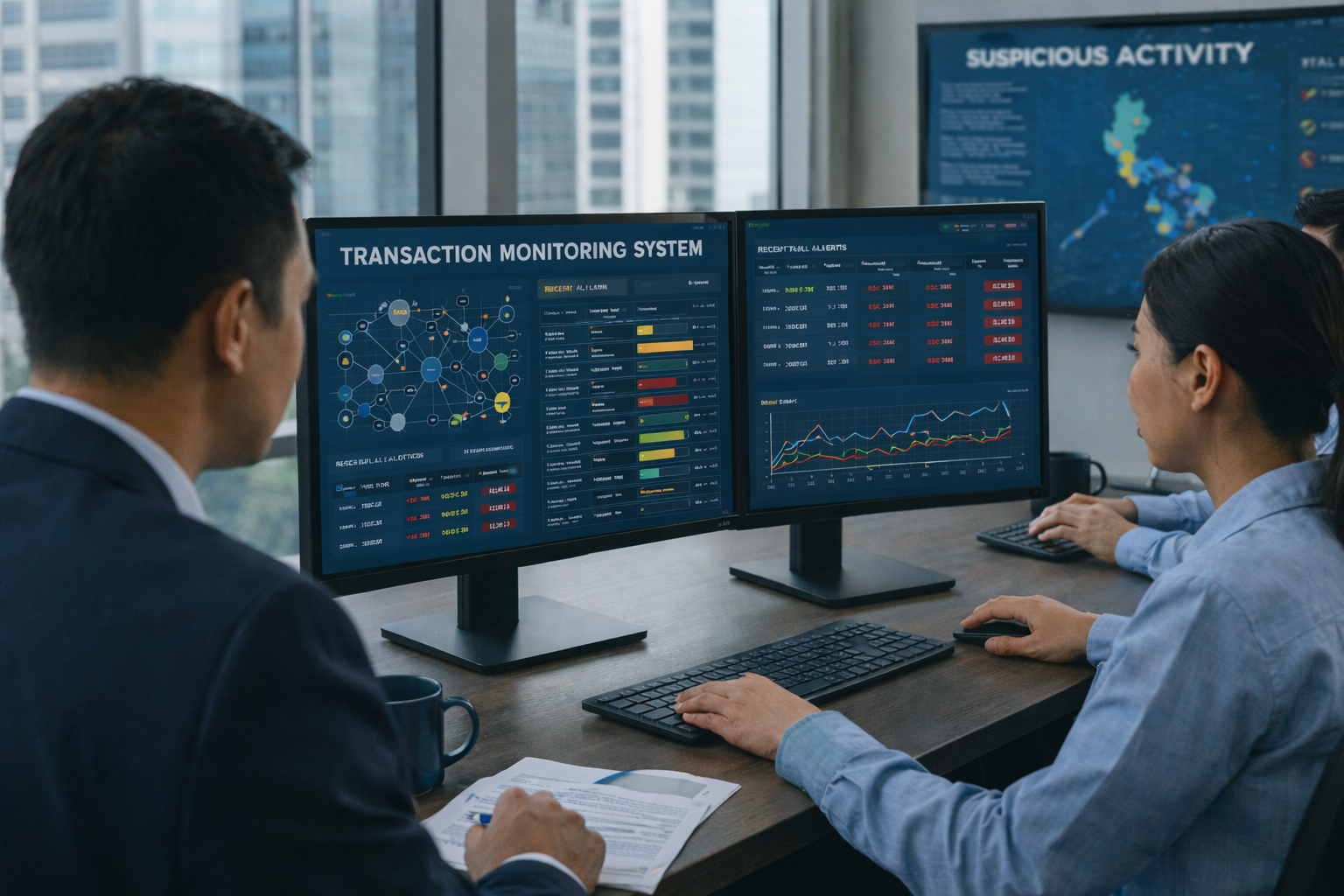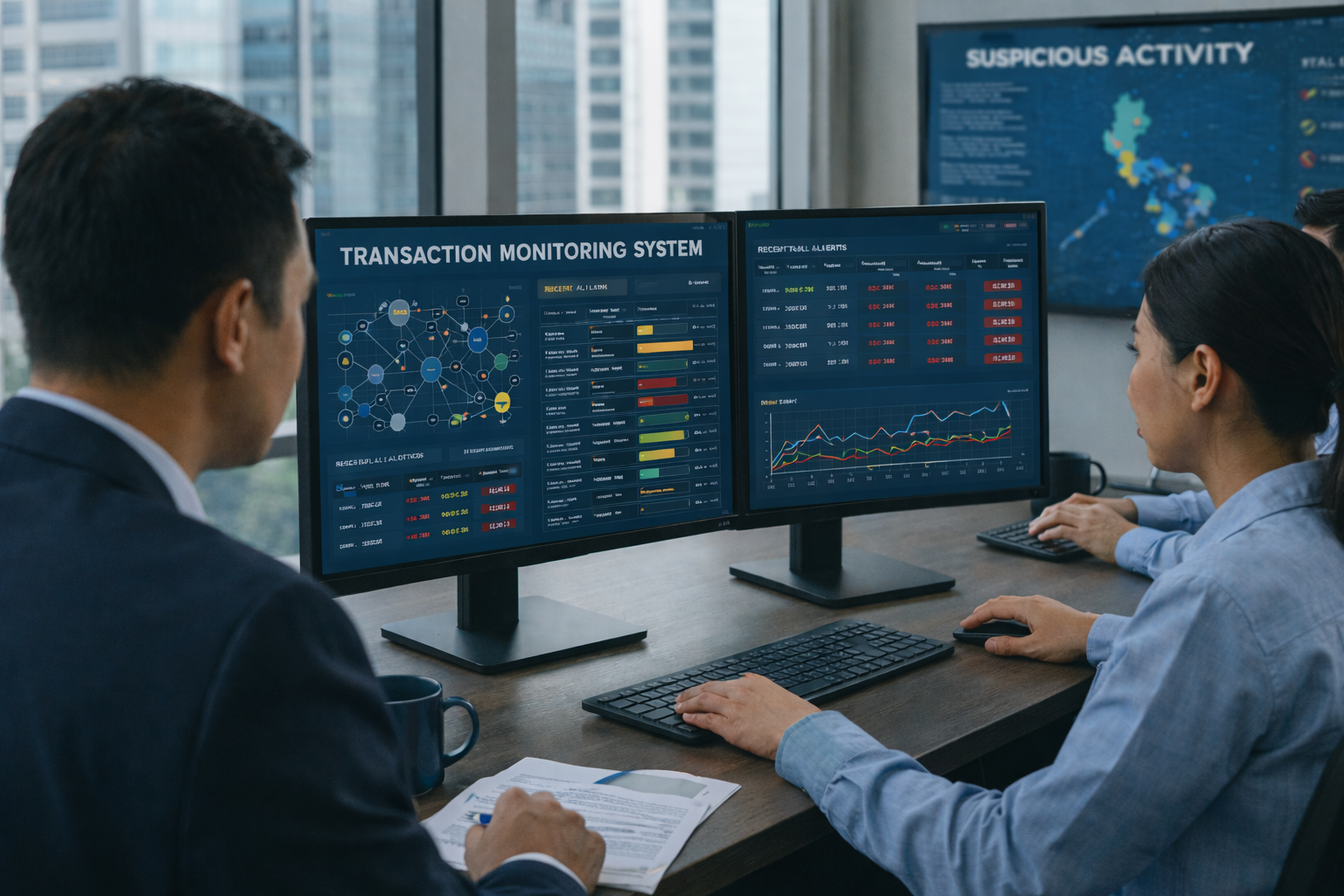Challenges in Anti-Money Laundering Compliance
.svg)
In the complex world of finance, anti-money laundering (AML) compliance presents a unique and ever-evolving set of challenges. For financial institutions, staying ahead of money laundering and terrorist financing threats requires navigating an intricate web of international and local regulations while leveraging technology to adapt to emerging risks.
Financial institutions in Singapore, Hong Kong, and the Philippines operate under stringent AML frameworks aligned with global standards, such as the Financial Action Task Force (FATF) recommendations. These jurisdictions, each with their own unique challenges, have implemented robust regulatory measures to combat financial crime effectively
The task of preventing financial crimes is not just about adhering to regulations. It's about developing effective AML compliance programs, integrating new technologies, and managing risks. It's about striking a balance between regulatory requirements and customer privacy.
This article aims to shed light on these challenges. It will delve into the complexities of AML compliance, explore the role of technology, and provide insights into future trends. The goal is to equip financial crime investigators with the knowledge they need to enhance their strategies and stay ahead of the curve.
The Evolving Landscape of Financial Crimes
Financial crimes are becoming increasingly sophisticated. Criminals are adept at exploiting vulnerabilities in the financial system. This evolution challenges financial institutions to adapt rapidly.
The globalization of finance has added complexity to money laundering schemes. Cross-border transactions provide anonymity and obscure illicit activities. This global network can hinder law enforcement efforts in detecting and prosecuting offenders.
Moreover, technological advancements contribute to the intricacy of financial crimes. Cybercrime and digital fraud have introduced new threats that demand modern solutions. Criminals leverage technology, making it essential for financial institutions to do the same.
Adaptation is key in this evolving environment. It requires constant vigilance, ongoing education, and the integration of innovative technologies. Financial crime investigators must stay informed to effectively combat these advanced threats.

AML Regulatory Frameworks in Singapore, Philippines, and Hong Kong
AML frameworks in Singapore, the Philippines, and Hong Kong are vital to combating financial crimes, ensuring compliance with global standards set by the Financial Action Task Force (FATF).
- Singapore: Guided by the Corruption, Drug Trafficking, and Other Serious Crimes (CDSA) and MAS AML/CFT Notices, Singapore enforces strict customer due diligence (CDD), suspicious transaction reporting, and risk-based approaches. Institutions face hefty fines for non-compliance.
- Philippines: The Anti-Money Laundering Act (AMLA), enforced by the AMLC, mandates transaction monitoring, enhanced due diligence, and remittance oversight. Recent amendments include virtual asset providers, aligning with FATF standards.
- Hong Kong: Under the Anti-Money Laundering and Counter-Terrorist Financing Ordinance (AMLO), financial institutions must report suspicious transactions, conduct CDD, and adopt a risk-based approach. Real-time monitoring technologies are encouraged to mitigate cross-border risks.
Core AML Compliance Elements
All three jurisdictions share these pillars:
- Transaction Monitoring: Real-time anomaly detection.
- Suspicious Transaction Reports (STRs): Timely reporting of potential risks.
- Risk-Based Approach: Focus on high-risk areas.
- Employee Training: Building awareness of financial crimes.
- Audits: Regular compliance checks.
{{cta-first}}
FATF's Role in Shaping Regulations
FATF recommendations guide these jurisdictions, emphasizing innovation through AI, machine learning, and advanced monitoring systems to combat evolving threats effectively.
By adhering to local laws and FATF standards, financial institutions can stay ahead of financial criminals while ensuring robust compliance.
The Role of Financial Institutions in AML Efforts
Financial institutions are at the forefront of AML efforts. They play a crucial role in detecting and preventing money laundering activities. Their involvement is vital due to their access to vast amounts of transactional data.
By implementing effective AML programs, these institutions help safeguard the financial system. They are responsible for identifying suspicious transactions and reporting them to authorities. This vigilance is essential for disrupting criminal networks.
Furthermore, financial institutions serve as the first line of defence in preventing money laundering and terrorist financing. They must balance compliance with federal laws while maintaining efficient customer service. This role requires a careful blend of technology and trained personnel.
Collaboration between financial institutions and regulatory bodies is also key. By sharing insights and best practices, they enhance their capability to combat financial crimes. This partnership fosters a culture of compliance, ensuring institutions remain resilient against evolving threats.
Technological Advancements in AML Compliance
Technology is transforming AML compliance efforts across the globe. Financial institutions are leveraging advanced solutions to enhance the efficiency and accuracy of their processes. These advancements are crucial in a world where financial crimes are growing more complex.
One major development is the integration of sophisticated transaction monitoring systems. These systems can process large volumes of data, identify suspicious activities, and reduce the occurrence of false positives. This ensures that resources are focused on genuine threats.
Data analytics also plays a key role. By analyzing patterns and relationships within data, institutions can gain insights into potential risks. This proactive approach can help prevent financial crimes before they occur.
RegTech, or regulatory technology, is another significant advancement. It automates compliance tasks, reducing both time and costs. This is particularly beneficial for smaller institutions with limited resources.
Below are some key technological tools in AML compliance:
- Transaction Monitoring Systems: Analyze vast data sets for anomalies.
- RegTech Solutions: Automate and streamline compliance processes.
- Data Analytics Tools: Provide insights into risk patterns.
Artificial Intelligence and Machine Learning
Artificial intelligence (AI) is a game-changer in AML compliance. It enhances the capability to detect and predict unusual transaction patterns. This is particularly valuable in handling large volumes of data swiftly and accurately.
Machine learning, a subset of AI, enables systems to learn and improve over time. As it processes more data, the algorithm becomes more adept at identifying suspicious activities. This reduces the occurrence of false positives, saving time and resources for financial crime investigators.
AI-driven tools also aid in customer due diligence. They can quickly analyze and verify customer identities against global watchlists. This speeds up compliance processes without compromising security.
By embracing AI and machine learning, financial institutions can stay ahead of evolving financial crimes. These technologies offer scalable solutions that grow with the needs of the organization, providing a competitive edge in combating money laundering.
Challenges and Solutions in AML Compliance
AML compliance comes with numerous challenges. One significant issue is the continuous evolution of financial crimes. Criminals are becoming more sophisticated, which makes detection more complex. This demands that institutions stay constantly vigilant and adaptable.
Another hurdle is the integration of new technologies into existing frameworks. Many institutions struggle with outdated systems, making it difficult to adopt modern compliance tools. This can lead to inefficiencies and potential gaps in monitoring.
Moreover, there is the challenge of regulatory changes. AML regulations are frequently updated, and institutions must keep pace. Falling behind can result in penalties and increased risk of financial crime.
To address these challenges, institutions can consider the following solutions:
- Invest in Technology: Upgrade systems to incorporate AI and machine learning.
- Enhance Training Programs: Ensure staff are well-informed of new threats and technologies.
- Adopt a Risk-Based Approach: Focus on high-risk areas to prioritize resources.
- Promote Collaboration: Share insights with other institutions to improve overall compliance.
Lastly, maintaining a strong compliance culture is crucial. By prioritizing ethical standards, institutions can better safeguard against money laundering activities.
Balancing Privacy with Regulatory Requirements
Balancing customer privacy with regulatory demands is a complex issue in AML compliance. Financial institutions must comply with strict regulations that often require detailed customer information. However, this can be at odds with privacy concerns from customers.
Data protection laws, like the General Data Protection Regulation (GDPR), further complicate this balance. Institutions must ensure that they collect, store, and handle customer data responsibly. This requires a careful approach to avoid infringing on privacy rights.
To achieve this balance, it's vital to employ transparent practices. Clear communication with customers about data use can build trust. Additionally, leveraging technology to enhance data security is essential. Encryption and anonymization techniques can protect sensitive information.
By prioritizing both compliance and privacy, institutions can build a trusting relationship with customers. This trust is vital in an era where data protection is increasingly important to consumers and regulators alike.
{{cta-whitepaper}}
The Future of AML Compliance: Trends and Predictions
AML compliance is poised for transformation as new trends and technologies emerge. Financial institutions must remain agile to adapt effectively.
One major trend is the increased use of advanced analytics. These tools can offer deeper insights into suspicious activities, enhancing risk management strategies.
Key Predictions for AML Compliance:
- Increased Regulatory Complexity: Expect more rigorous AML regulations globally.
- Greater Use of RegTech Solutions: Technology-driven solutions will streamline compliance processes.
- Focus on Proactive Risk Management: Shifting from reactive to proactive strategies will become crucial.
Additionally, the role of collaborative efforts is expanding. Cross-border cooperation and information sharing among institutions are vital for tackling money laundering efficiently.
As the landscape evolves, staying informed and proactive will be key. Institutions that leverage emerging trends and technologies can better safeguard against financial crimes and ensure robust AML compliance.
Conclusion: Strengthening AML Strategies with Tookitaki's FinCense
As the landscape of financial crime continues to evolve, financial institutions face mounting challenges in maintaining effective Anti-Money Laundering (AML) compliance. To combat these complexities, Tookitaki's FinCense emerges as the ultimate solution, revolutionizing your AML compliance landscape.
With efficient, accurate, and scalable AML solutions for banks and fintechs, FinCense ensures that organizations can achieve 100% risk coverage for all AML compliance scenarios. By leveraging the Tookitaki AFC Ecosystem, institutions gain comprehensive and up-to-date protection against financial crimes, staying a step ahead of evolving threats.
One of the most compelling benefits of FinCense is its ability to reduce compliance operations costs by 50%. By utilizing its advanced machine-learning capabilities, FinCense minimizes false positives and enables teams to focus on material risks, drastically improving service level agreements (SLAs) for compliance reporting (Suspicious Transaction Reports - STRs).
FinCense offers an unmatched 90% accuracy in detecting suspicious activities in real time, empowering institutions to monitor billions of transactions efficiently. The integration of an automated sandbox allows teams to test various scenarios, reducing deployment efforts by an impressive 70% and cutting down false positives by 90%.
The onboarding suite facilitates seamless real-time screening of multiple customer attributes, leading to accurate risk profiles with exhaustive, pre-configured rules on KYC (Know Your Customer) data. This ensures that institutions get precise insights for millions of customers, greatly enhancing their risk assessment processes.
Additionally, FinCense's smart screening capabilities guarantee regulatory compliance with precise matching against sanctions, Politically Exposed Persons (PEP), and Adverse Media lists in over 25 languages. With customizable configurations and efficient testing using the built-in sandbox, organizations can effortlessly stay compliant while optimizing their operational efforts.
Utilizing powerful customer risk scoring tools, FinCense allows institutions to make informed decisions backed by dynamic risk engines and comprehensive risk profiles. With 200+ pre-configured rules and the flexibility to add custom parameters, organizations can visualize hidden risks and complex relationships, enhancing their overall risk management strategies.
The smart alert management feature further enhances efficiency by reducing false positives by up to 70%, leveraging advanced machine learning models for sustained accuracy over time. With a self-learning mechanism and an explainable AI framework, teams benefit from clear insight into alert analysis while seamlessly integrating with existing systems for a faster go-live.
Moreover, the case manager simplifies investigations by aggregating alerts at the customer level, allowing financial crime teams to focus on holistic customer analysis rather than individual alerts. Automating STR report generation and managing low-risk alerts efficiently leads to a 40% reduction in investigation handling time, enhancing real-time visibility and operational efficiency.
In conclusion, with Tookitaki's FinCense, financial institutions are equipped with a comprehensive, intelligent, and adaptable AML compliance solution that empowers them to thrive in the face of evolving financial crimes. By embracing this advanced technology, organizations can safeguard their operations against money laundering and ensure robust compliance with regulations, ultimately contributing to a safer financial ecosystem.
Experience the most intelligent AML and fraud prevention platform
Experience the most intelligent AML and fraud prevention platform
Experience the most intelligent AML and fraud prevention platform
Top AML Scenarios in ASEAN

The Role of AML Software in Compliance

The Role of AML Software in Compliance










